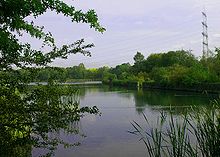Fining pond


A fining pond serves to improve the quality of wastewater ( fining ) from sewage treatment plants . At the same time, the ponds often form humid biotopes and, due to their seclusion, are important places of retreat for the corresponding plants and animals.
The pond is typically downstream of the biological or plant -based sewage treatment plant , it is located outside of their premises and has no equipment (aeration, addition of flocculants, adjustment of the pH value, etc.), as would be common in a sewage treatment plant. The cleaning of the water from suspended matter and the equalization of the water quality in terms of oxygen content ( COD , BOD 5 ) as well as hygienic and aesthetic properties at the downstream receiving waters is done by the long residence time in the natural pond . It is usually a few days, but can be shorter if there is heavy rainfall. The fining pond also partially acts as a rain retention basin. Other additional uses as cattle trough or extinguishing water pond are common.
The pond has an open surface, is overgrown with aquatic plants and stocked with fish, it can also be used as a fishing spot. Its geometry should be designed in such a way that it is completely traversed by the water that is passed through. This is achieved through elongated ponds or the series connection of several ponds with partition walls. Planted filter or seepage dams or height-adjustable walls hold back suspended matter, algae or fish.
The biological equilibrium is aerobic (rich in oxygen), but excessive nutrients (phosphorus, nitrogen) from the sewage treatment plant can lead to significant algae growth and a deterioration in the water quality. This can be counteracted by a shorter dwell time of less than two days. This is usually controlled via the height of the inlet and outlet.
Finishing ponds are not subject to the Waste Water Ordinance , but are additional, voluntary measures to improve water quality.
